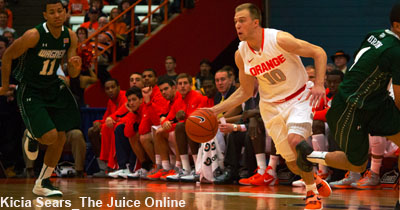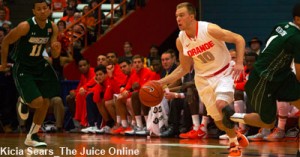
In the second of a three-part series, Jeff Irvine breaks down Syracuse’s offseason needs on a player-by-player basis. This week, he takes a look at Syracuse’s guards.
Over the next four months, Syracuse’s returners from last year’s Final Four run will hit the weight room, mix it up in summer leagues, and spend countless hours alone in the gym shooting. It is the same ritual every year, and Syracuse has seen some remarkable transformations – and some not so much.
How can an Orange player make sure he’s ready come Midnight Madness? Fortunately, I’ve put together a list of historical role models they can look to for advice and some examples they would be wise to avoid.

Trevor Cooney
After a redshirt year where he simply had too many players in front of him in the rotation, big things were expected out of Cooney last year. We all know how that turned out. Now Syracuse must rely on the least experienced backcourt it has had in years. Cooney will compete with Duke transfer Michael Gbinije and freshman Ron Patterson for time beside freshman point guard Tyler Ennis. If Cooney is to see the court consistently, he will need to regain the form that gained him the reputation as a sharp shooter in high school.
» Related: A look at Syracuse’s 2013-14 wings
Player to emulate: Andy Rautins, summer of ’06. Rautins also came to SU with the reputation of 3-point specialist, but he only shot 32.6 percent his freshman season. This is a lot better than Cooney’s 26.7 percent, but Cooney should take Rautins’ sophomore-year improvement as an example. Rautins improved his 3-point percentage to 35.6 percent while connecting on 67 shots from behind the arc in 21 minutes per game. If Cooney could do the same, most Orange fans would be happy. And if Cooney continued on Rautins’ trajectory, then the future would bode very well.
Example to avoid: Josh Wright, summer of ’05. Josh Wright came to Syracuse as a highly rated point guard in 2004 (#36 overall in the RSCI). He was meant to be McNamara’s backup and eventual replacement. Wright saw little playing time his freshman year and ran into trouble off the court. Despite a few highlights, he showed little improvement in his sophomore season and the rest of his career. He lost his starting spot his junior season, and he quit the team the following year because of personal and academic issues. There’s no reason to believe Cooney will have the same troubles, but if he fails to improve like Wright, he will similarly be replaced on the depth chart.
Michael Gbinije
Gbinije was the 28th ranked recruit in the 2011 class, just three spots behind Michael Carter-Williams. After sitting out last season, the Duke transfer will now battle Cooney and Patterson for minutes as SU’s shooting guard. How he will perform has been subject to much speculation, but the transfer will remain an enigma until October at the earliest. He’s known to have a jump shot and handled the ball as the second-team point guard during SU’s practices this past season.
Player to emulate: Wesley Johnson, summer of ’09. We all know what the Iowa State transfer did in his one season on the Hill. Not realistic expectations for Gbinije? Ok, how about Jason Cipolla, summer of ’95. The Tallahassee Community College transfer, who is built in the same mold as Gbinije, averaged 10.2 ppg and 2 apg in his two seasons at Syracuse. Most importantly, in his first season he hit one of the most important shots in Syracuse history to help the ’95-’96 team reach the NCAA Championship Game.
» Related: A look at the 2013-14 SU hoops team
Example to avoid: Matt Tomaszewski, summer of ’10. For some reason, the University of Tampa transfer never managed to see much playing time. Hopefully Gbinije can avoid the same fate.
Tyler Ennis
Player to emulate: Gerry McNamara, summer of ’02. Ennis could do worse than choosing the only Syracuse freshman point guard to lead the team to a National Championship as his role model.
Ron Patterson
Player to emulate: Dion Waiters, summer of ’09. A big, physical guard, Patterson’s playing time will depend on the performance of Gbinije and Cooney because the shooting guard spot is presumably theirs to lose. Even if the more “established” guards perform well, Patterson could still see playing time as a physical defensive stopper. Waiters certainly came to Syracuse with more hype and expectations, but he arrived to find a backcourt crowded with more established players and did not start. Waiters used his physical tools to earn playing time, and Patterson will have to do the same.
For more Syracuse coverage, Like our Facebook page and follow us @TheJuiceOnline.

